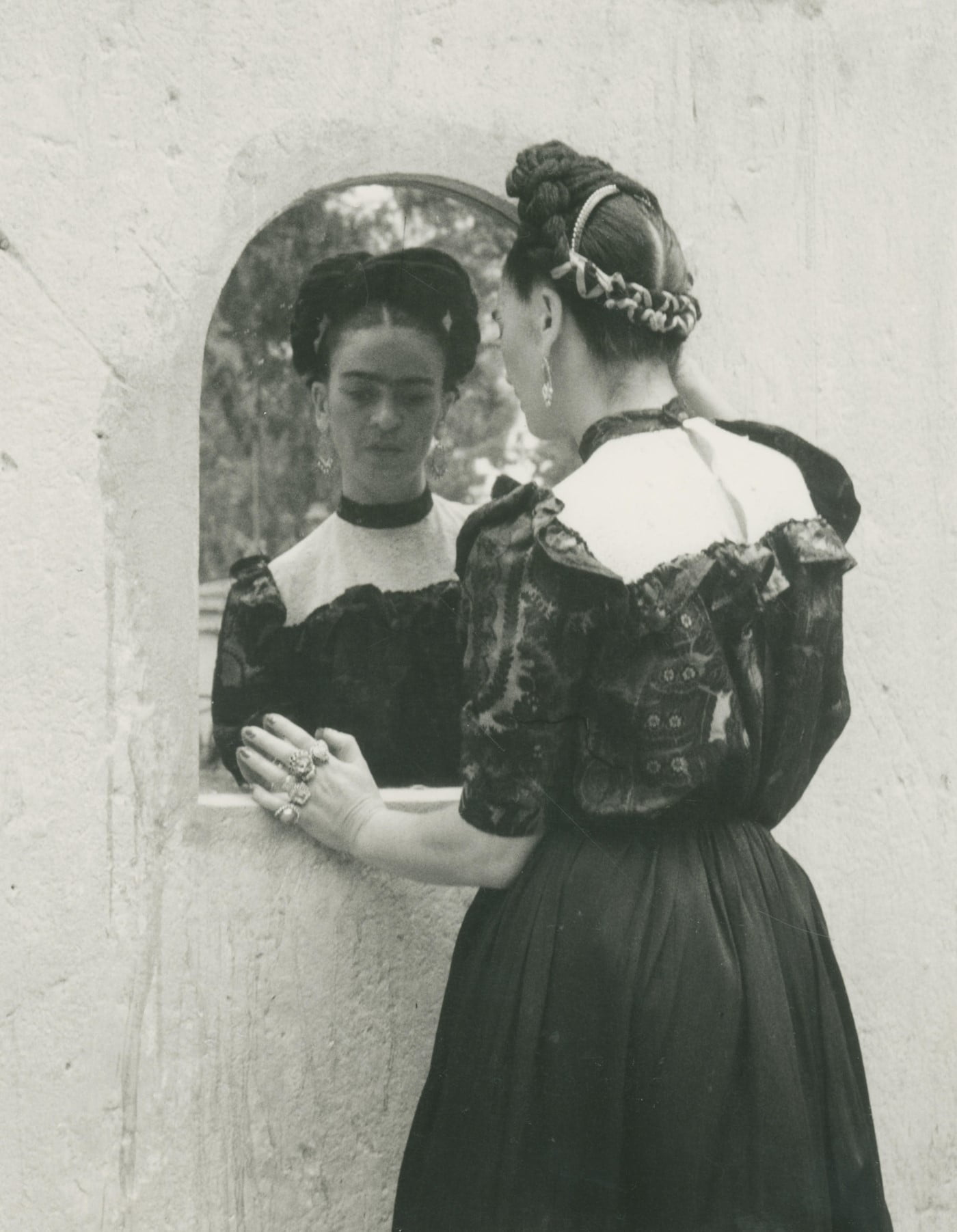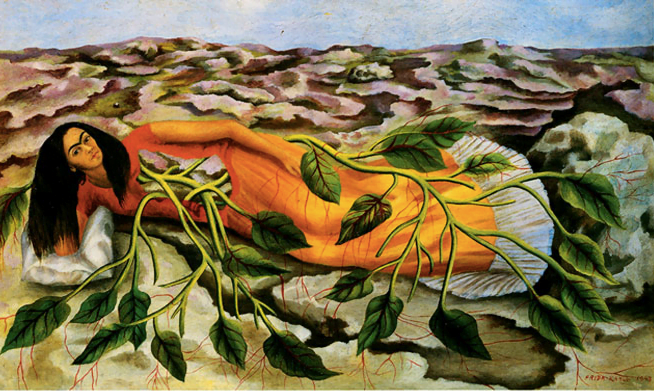The pallet of feminist metaphors in the artworks of Frida Kahlo has saturated personal tales of revolt and an individual journey which has a vast impression on the liberated drifts of art, culture and feminism.
Woman artists have a record of getting judged and undervalued for picking domestic, personal and in-house themes but the intensifying fame of Frida critiques the narrow mindsets which are stuck to the ironic mechanism of finding the straight social or political appeal.
Woman artists have a record of getting judged and undervalued for picking domestic, personal and in-house themes but the intensifying fame of Frida critiques the narrow mindsets which are stuck to the ironic mechanism of finding the straight social or political appeal.
Art emerges from the deepest wounds and the most dreadful scars which have the power to consume the complete purpose of one’s being. In the entire history of creative expression, women have been using more diverse themes and imageries than men. We often see flickers of crushed rage, depiction of nature, longing for change, call for help, domestic conflicts, love, marriage, family linked subjects and in-house symbolism in the paintings of female artisans.

Till now, the relevance and pervasive influence of the works of female artists have been under the serrated claws of unfair critical approaches but the fame of Frida Kahlo poses a challenge for such bigoted critics who wish to dominate the art-industry through male-metaphors of colours. Whenever these chauvinist commentators define the feminine pallets and themes as topics of no collective or societal value, I want to point them towards the innovative and vanguard frames of Frida Kahlo.
Frida Kahlo’s journey of resistance and rebellion
The artistic land-mass of Frida is headed by self-portraits and her life-story is a seamless feminist potion of incredible resistance and rebellion. Apart from the complicated marriage with artist Diego Rivera who was 20 years older than her, she survived the tragic pain of polio, spina-bifida, a hazardous bus-accident and 3 miscarriages. Even mapping these trails leaves one astonished over the incredible courage she had as an artist and female icon.

Just evaluate, Frida who created her first self-portrait at the tender age of eighteen, later won the commercial showground and ruled the art-galleries in Mexico and the USA. Frida, who embarked under the premature influence of her envious husband, later became the identity-font of Diego and her homeland. In the early epoch, her undersised canvases were criticised and classified as “vulgar” in the conservative native art-world till she acquired the profuse markers of international status.
Frida, who embarked under the premature influence of her envious husband, later became the identity-font of Diego and her homeland. In the early epoch, her undersised canvases were criticised and classified as “vulgar” in the conservative native art-world till she acquired the profuse markers of international status.
However, her thirst for expression was never diminished. Far from the grip of sexist and malicious criticisms, she proved that the most powerful triumphs are made of tender, trivial and intimate things.
How Frida’s personal themes contribute to feminist mutiny
Frida has been a charismatic role model for the youth and her personal journey pinpoints strong hallmarks on the path of feminist agitation. In her self-portraits and other different artworks, she painted nature, hummingbirds, deer, monkeys, hospital-beds, reflections of childhood, trauma, family and friends, thorn and flowers, blood and threads to express her pain, relationship, identity and conflicts of self-image. Through the use of surreal style, portrayal of nature and cubism, she highlighted the tapered typecasts, her physical-emotional ordeals, the scabs of social disapproval, the jealous cords of Diego, the remains of a doomed marriage and depressive episodes.

Art-enthusiasts need to know that in the wake of pressures to suppress the voice and attempts to morph the rage of women, even the slightest spark and the most minuscule shards of female expressions are acts of great significance. When the brook of social-opinion can invade, decide and demolish the private boundaries, why can a personal tale not influence and navigate the social remit? Frida is an impeccable example of rejoicing the somatic and emotive scars- a flower of temper which can gently devastate the toxic masculine sense of art-review.
A witty observer should be able to crack the ground feminist puzzles of her struggles. It is quite astonishing how she paints the floating shadows of loss and childhood memories on water surface, making a concrete ground to stand up and record the svelte moves of life as a young independent woman.
Frida’s self-portraits as a medium of societal annotations
In her words, she believed in ‘not building a wall around suffering‘. Her feted self-portraits have the power to shape and shake the outward cultural and social structures. As a childless woman, her pain spilled out on canvas through the emission of cracked desires in the Roots, marking the prerogative toxic approaches of society towards the womanhood and the utter glorification of maternity. Her art shades light on the community-casks women have been facing across the world from a long-gone era till now.

For instance, her pain of spine-operation on the canvas of The Wounded Deer is not only a personal tale of suffering but an unwavering expression of treachery, deceit and exclusion brave women have witnessed during the first wave of feminism. These themes and allegories need wide-angled visionary eyes to grasp the hidden footnotes and read between the colours.
The conflict and political metaphors of rage
Her private passages consist of the filaments of the Mexican cultural and governmental revolution which rose during the early decades of 20th century. Some bigoted critics claim that her subjects do not appeal to the fundamental issues or political throngs but it is notable that Frida was a part of the Communist Party of Mexico. Therefore, her depiction of cultural conflict can hook an eye as the synthesis of clash between the typical Mexican image and the western inclinations. Frida owned her paradoxes like a true sovereign and grew through life-battles.

Her lucid and colourful metaphors of rage are hammers on the cage of patriarchy. When the male-dominant artsy aptitudes were dogged to discriminate and draw a line between cultural inclinations, she put a beautiful link between the two dimensions, crafting a bridge, filling the gap, connecting through the delicate red thread of pain, catching the tensions via magical-realism, imagination, emancipation of nature and the hidden political aurora of quiet private things.
A challenge to the beauty standards and influence on pop culture
Frida created more than 200 paintings and survived more than 30 operations in her petite but flourishing life. Her various experiments with fashion have inspired generations beyond age braces. In the Self-portrait with Cropped Hair she renders in a different appearance, denying the beauty-standards, setting a vital, communicative milestone for the stalwart thirst for change.

Taking a step ahead, she added a flowy, floral touch to Mexican attires to cover up her stiches, spine-condition and polio-effects. The fashion-industry hailed her poppy novelties and the gentle headband of flowers on the head. The escalating trend of her influence over artists, colour pallets, style props, funky jewels, pop-culture and bohemian lifestyle pulls her from the frame of art-icon, pushing the boat out and creating a space on a much wider life-scale.
In the sphere of Frida, the personal is politically aware and highly relevant and each stroke of brush has the power to connote a drift of change! The art-persons need to understand that the personal voice of female existence has much more extensive range and influence than narrow-minded confines can estimate.
About the author(s)
Mariyam (she/her) has a thirst for journalistic and creative stories that consist of feminist, humanitarian, contemporary or artsy themes. She hails from a Political Science, English Literature academic background and an Urdu-Hindi crux.
For her, words are a visionary sovereignty to stand on and find the meaning of being while journalism is the only place where truth comes with utmost clarity, facts and data. When not weaving pointy narratives or poetic expressions, she loves mingling with cats or delving into photography, cinema, music, daydreaming and stargazing.






